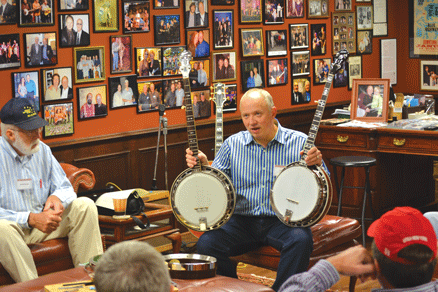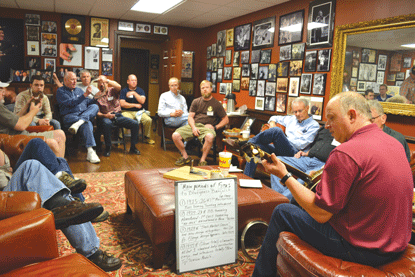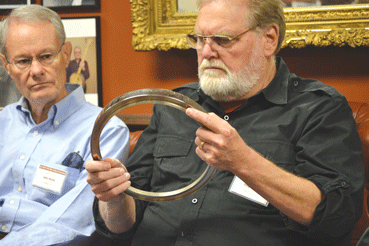Pre War Seminar Banjo Newsletter Article
The Jim Mills PreWar Banjo Seminar
As printed in the June 2014 Banjo Newsletter – Used by Permission
Story and photos by Richie Dotson
 April 12, 2014 marked the fifth Jim Mills Pre War Gibson Banjo Seminar. The first was held on October 9th, 2010, and it, like the ones that followed, was at capacity. This gathering of pre-World War II Gibson banjo enthusiasts, owners, truth seekers, the curious, the novice historians, is like no other the banjo world has ever seen.
April 12, 2014 marked the fifth Jim Mills Pre War Gibson Banjo Seminar. The first was held on October 9th, 2010, and it, like the ones that followed, was at capacity. This gathering of pre-World War II Gibson banjo enthusiasts, owners, truth seekers, the curious, the novice historians, is like no other the banjo world has ever seen.
So much speculation, assumption, and frankly, voodoo, has surrounded these banjos, especially the rare, pre-war flathead five-string variety made famous by people like Earl Scruggs, Don Reno, J.D. Crowe, Sonny Osborne and Jim Mills, to name a few. These are the most desirable of the pre-war Gibson banjos, and in the banjo world could be compared to Stradivarius violins in rarity, tone and playability. Jim Mills is the owner/caretaker of the largest privately held collection of these banjos on the planet. On the surface, one might assume that the purpose of the seminar is to get to play one of these banjos and experience it in the magical setting that is Jim Mills’ banjo showroom…and you would be partially correct. But there is much more to this seminar than getting to play these powerful old banjos.
From the onset of the meet and greet (held the evening prior to every seminar) to the last handshake and hug goodbye, attendees are immersed in the history of these banjos. That history goes far beyond the vague catalog descriptions that Gibson published between the 1920s and the onset of World War II, which are all examined in detail throughout the course of the day. Jim’s collection extends to nearly every conceivable part of these banjos—tailpieces, armrests, tuners, flanges, tone rings, tension hoops, wood rims, necks, etc. etc. Enrolled members get to hold and examine the variations of all the parts made throughout that period. Participants c
an actually see which parts typically came on which models and learn to tell the difference between the real thing and the modern reproduction parts that have been manufactured for many years now. Variations in stain color and inlay patterns throughout the years on things like wood rims and even the types of screws, binding and “L” brackets used during different time periods are examined. When you leave the seminar, you will have experienced nearly every aspect of the pre-war Gibson banjo. Extensive hands-on study of different model designations such as TB, PB, RB, GB, MB, style 00, 1, 2, 3, 4, 5, 6, 7, 11, 12, 18, Granada, etc. are discussed, as well as the different wood types, tuning machines, other metal components and even plating that the Gibson factory utilized during the pre-war years.
 The day of the seminar begins with coffee, water, muffins and a relaxed stroll around the 1,000 square foot banjo showroom at your own pace, where you’re free to soak in the huge collection of banjos, parts, a few transient and experimental banjos produced by Gibson, an impressive collection of early bluegrass memorabilia—including hundreds of photographs, handbills, posters, and even some of the original templates used to make these banjos. It is always exhilarating to witness the hush that falls over the first-time attendee as he or she begins to soak in the thousands of well-organized bits of historically significant pieces in the room. For some, the stop along the wall dedicated to Lester Flatt and Earl Scruggs that contains some of Earl’s own personal contributions to the showroom leaves the most powerful first impression. For others, it’s getting an up close look at Jim’s workbench where there are always a couple of banjos awaiting set-up and assembly, or perhaps a tenor banjo that’s being converted to 5-string. And for others, the parts display case, or the wall containing approximately 200 Gibson tenor, plectrum, guitar banjo and mandolin banjo necks, holds their fascination longest. Whatever the reason, the showroom itself speaks to everyone differently. The plethora of pre-war Gibsons and thousands of related pieces are priceless to the onlooker and historian alike.
The day of the seminar begins with coffee, water, muffins and a relaxed stroll around the 1,000 square foot banjo showroom at your own pace, where you’re free to soak in the huge collection of banjos, parts, a few transient and experimental banjos produced by Gibson, an impressive collection of early bluegrass memorabilia—including hundreds of photographs, handbills, posters, and even some of the original templates used to make these banjos. It is always exhilarating to witness the hush that falls over the first-time attendee as he or she begins to soak in the thousands of well-organized bits of historically significant pieces in the room. For some, the stop along the wall dedicated to Lester Flatt and Earl Scruggs that contains some of Earl’s own personal contributions to the showroom leaves the most powerful first impression. For others, it’s getting an up close look at Jim’s workbench where there are always a couple of banjos awaiting set-up and assembly, or perhaps a tenor banjo that’s being converted to 5-string. And for others, the parts display case, or the wall containing approximately 200 Gibson tenor, plectrum, guitar banjo and mandolin banjo necks, holds their fascination longest. Whatever the reason, the showroom itself speaks to everyone differently. The plethora of pre-war Gibsons and thousands of related pieces are priceless to the onlooker and historian alike.
Jim’s presentation eventually gives way to questions. Even though Jim always plans to present a set curriculum, every seminar varies depending on the interaction of the participants. One of the most fascinating departures is a discussion of the many anomalies Gibson produced during this period, many of which are still being discovered. Jim’s collection contains many Gibson odditys, and I’m always surprised at the responses to some of the unusual inlay combinations and materials that Gibson occasionally mixed together. One of the oddest, recently added to Jim’s collection, is a Gibson tenor banjo neck designated for a style 11. The style 11 banjos were painted blue so usually their necks were plain, straight grained maple, but occasionally you find these necks built from the other woods that Gibson used for the majority of their banjos, such as mahogany or walnt. This neck was made from a beautiful piece of Brazilian rosewood! The neck had been stripped of finish some time ago, revealing the rare secret after more than 70 years.
curriculum, every seminar varies depending on the interaction of the participants. One of the most fascinating departures is a discussion of the many anomalies Gibson produced during this period, many of which are still being discovered. Jim’s collection contains many Gibson odditys, and I’m always surprised at the responses to some of the unusual inlay combinations and materials that Gibson occasionally mixed together. One of the oddest, recently added to Jim’s collection, is a Gibson tenor banjo neck designated for a style 11. The style 11 banjos were painted blue so usually their necks were plain, straight grained maple, but occasionally you find these necks built from the other woods that Gibson used for the majority of their banjos, such as mahogany or walnt. This neck was made from a beautiful piece of Brazilian rosewood! The neck had been stripped of finish some time ago, revealing the rare secret after more than 70 years.
Time is also dedicated to the study of accessories, such as the cases that these banjos came in, and the Rogers calfskin heads that came standard—and the fact that up until 1959, our favorite 5-string players were recorded using these heads.
Every participant is treated to a catered lunch of North Carolina-style pork barbecue and
chicken with all the fixin’s provided by a local eatery located a few miles up the road. Jim’s beautifully landscaped backyard and Charleston-style back porch serves as the perfect location to enjoy lunch while getting to know some of the other folks attending the seminar.
There is no other place in existence more dedicated to the preservation, education and knowledge of the most copied banjos on earth, and Jim is one of the foremost authorities on the subject. Many people consider these the best sounding, best balanced and most powerful banjos in existence, but you don’t have to rely on someone else’s hearsay. After attending a Jim Mills seminar you’ll leave with your own opinion, having studied and even played some of the greatest pre-war Gibsons ever assembled in one location!
For more information about upcoming seminars, please Click Here